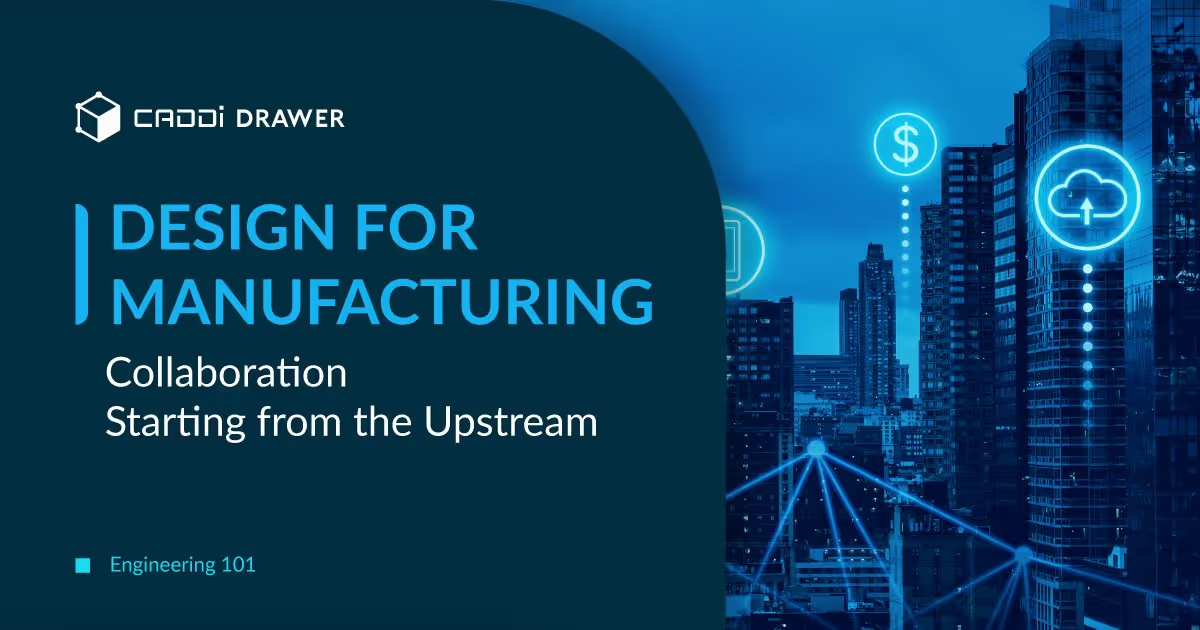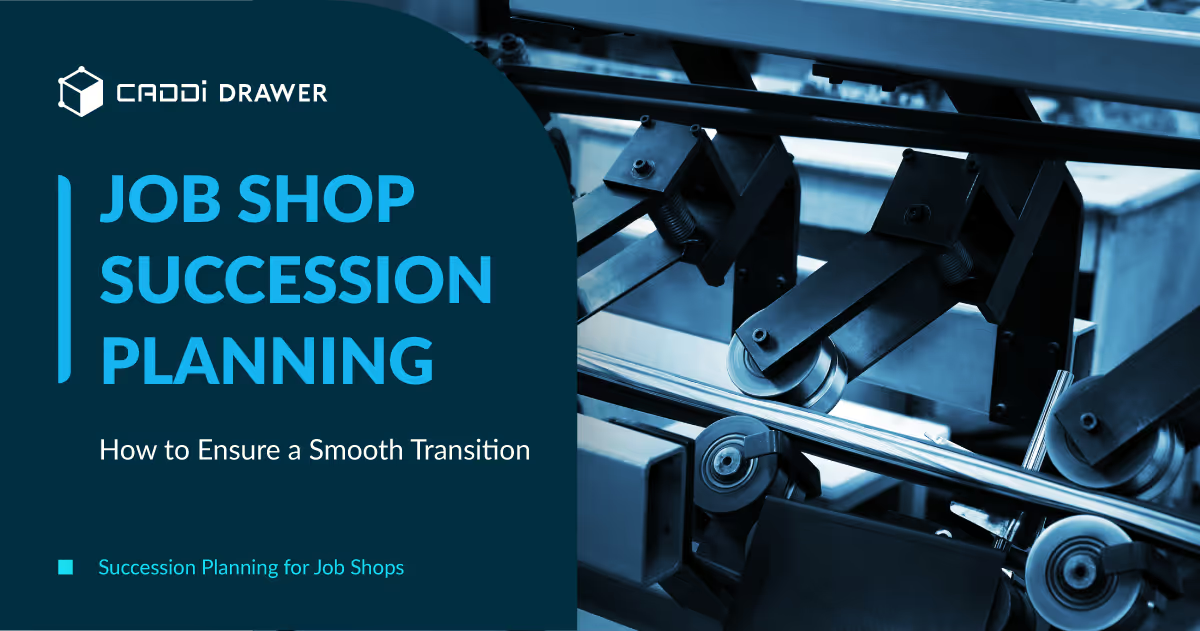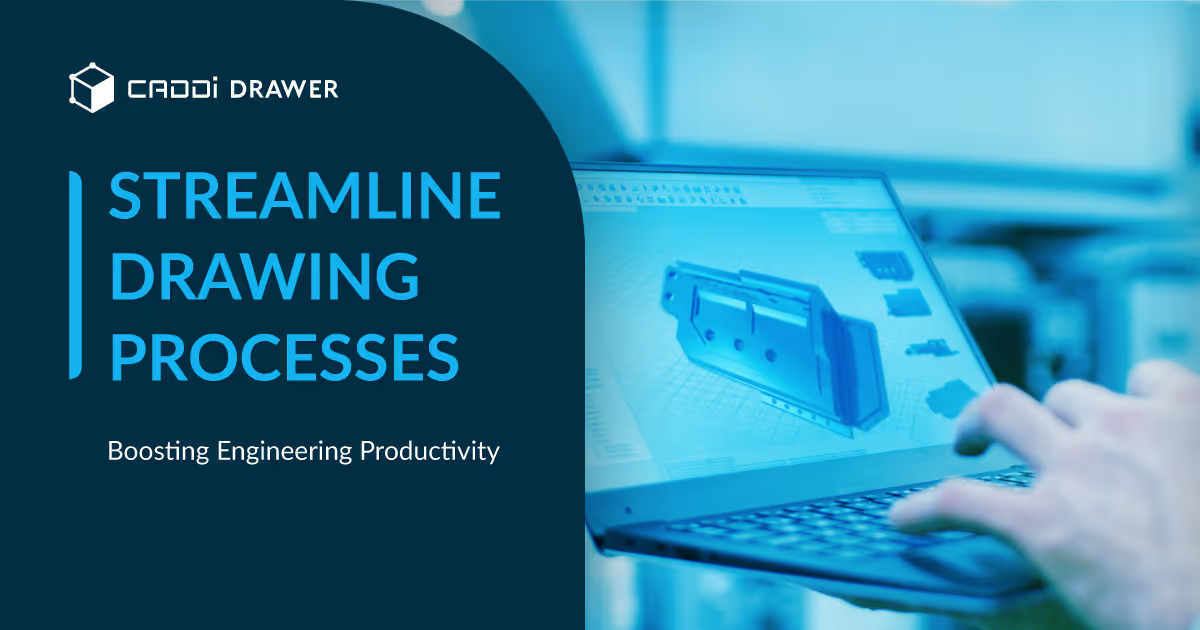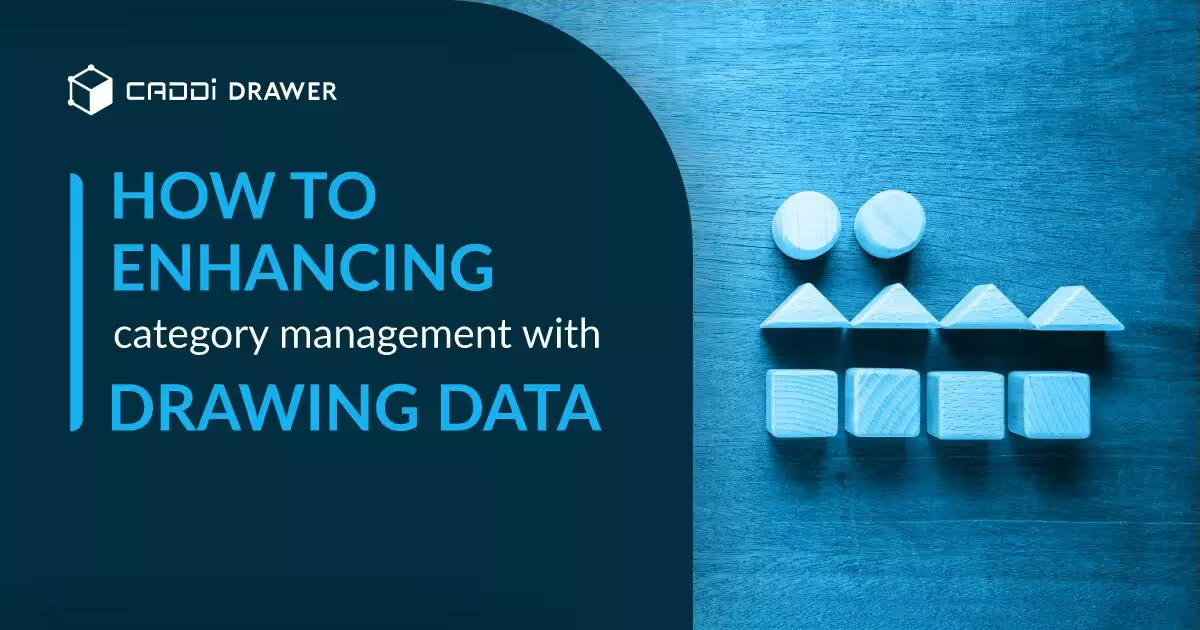Engineering 101: Design for Manufacturing – Collaboration starting from the upstream

Table of Contents

Design for Manufacturing is an approach that involves developing and designing products with ease of manufacturing in mind. It emphasizes integrating manufacturing process considerations into the engineering phase, aiming to optimize production methods and processes while maintaining quality and functionality.
The benefits of adopting DFM are multifaceted, including substantial cost reductions, enhanced product quality, shorter cycles of development and production launch, and a streamlined product development process.
It is often said that 80% of a product’s cost is determined by its design. Conversely, this implies that there is a limit to the cost reduction achievable solely through procurement and manufacturing. DFM is precisely aimed at optimizing this 80% portion.
Understanding Design for Manufacturing (DFM)
DFM revolves around six main principles: process, design, material, environment, and compliance. Understanding and applying these principles effectively can lead to successful outcomes in manufacturing.
Tolerances: One of the most critical aspects of DFM is the specification of tolerances. The geometric tolerance required for a component directly influences its manufacturing cost. For example, specifying tighter tolerances than necessary can lead to increased costs due to the precision required in the manufacturing process. A practical approach is to specify the loosest tolerance that will still meet the functional requirements of the component, thereby minimizing unnecessary manufacturing costs without compromising product quality.
Process: The choice of manufacturing process is foundational in DFM. For instance, injection molding is ideal for producing high volumes of a part, while 3D printing technologies like Multi-Jet Fusion or Selective Laser Sintering are better suited for low-volume, highly detailed parts. The manufacturing process impacts the final cost and efficiency, making it essential to choose the right one based on the part’s quantity, properties, and required materials.
Design: The design phase must consider the chosen manufacturing process’s specifics, such as wall thickness, surface details, and transitions. DFM advocates for simplicity to minimize complexity and risk, although not all designs can be simplified. The right design software, tailored to the specific manufacturing technology, is crucial to avoid errors and ensure the part’s success.
Material: Selecting the appropriate material depends on the final part’s application and required properties, such as heat resistance, water resistance, strength, and flexibility. The material choice is a critical factor that influences the part’s functionality and durability.
Environment: The environment in which the final product will be used also affects the design. Parts used in industrial settings might need to withstand more stress or force compared to those used in office environments. Designers must consider the operational environment to ensure the part’s longevity and performance.
Compliance and Testing: Parts may need to adhere to industry-specific, internal, or third-party standards, especially if they are used in regulated environments (e.g., food-safe standards). Planning for compliance and testing is essential to meet these standards during the DFM process.
Examples and Applications of DFM
Examples of DFM applications include the following cases.Of course, it should be noted that the perspectives mentioned here are merely a part of the considerations for each manufacturing process, and there are many other factors that should also be taken into account.
Injection Molding
- Uniform Wall Thickness: Essential for preventing defects such as warping, sink marks, or incomplete filling. Uniform thickness ensures even cooling and solidification, which is crucial for the structural integrity and aesthetic quality of the part.
- Simplicity of Design: Simplifying the design can significantly reduce costs and manufacturing time. Complex designs may require more sophisticated and expensive molds, increasing both the initial investment and the risk of production issues.
- Draft Angles: Including draft angles in the design makes it easier to eject the part from the mold, reducing the risk of damage and improving the efficiency of the manufacturing process.
3D Printing
- Complex Geometries Without Tooling: One of the major advantages of 3D printing is its ability to produce complex shapes that would be difficult, expensive, or impossible with traditional manufacturing methods. This allows for greater design freedom without the need for expensive tooling.
- Material and Detail Resolution: The choice of material and the printer’s resolution can greatly affect both the functionality and the aesthetic of the part. Different materials and printing technologies offer varying levels of detail, strength, flexibility, and temperature resistance.
- Orientation and Support Structures: The orientation of the part during printing and the use of support structures can influence the surface finish, strength, and the amount of post-processing required. Strategic design can minimize the need for supports and optimize the part’s performance.
Sheet Metal Fabrication
- Bend Radius and Material Thickness: Knowledge of the specific material’s properties is crucial, as it affects how the material can be bent or formed. Designing with appropriate bend radii and material thickness ensures that parts can be manufactured without cracking or deforming.
- Corner Designs: Efficient designs incorporate features that accommodate the fabrication process, such as specifying corner reliefs to prevent tearing during bending.
- Efficient Use of Material: Designing parts to fit within standard sheet sizes or to nest within each other’s outlines can reduce waste and lower material costs.
Steps to Implement DFM in Your Projects
Implementing DFM effectively involves several strategic steps, each designed to integrate manufacturing considerations early in the product design phase:
Early Incorporation of DFM Analysis: The sooner DFM analysis is applied in the design process, the greater the opportunity to make impactful changes. This early integration is crucial for addressing manufacturing and sustainability considerations before the commencement of tooling, thereby unlocking all potential benefits of DFM.
CAD-based software could play a key role here, offering the ability to forecast part quality and performance through finite element analysis (FEA). This capability helps to refine the design process from the start, guaranteeing that designs are primed for manufacturing efficiency.
Manufacturing Cost Modeling: Beyond the design and material considerations, DFM also involves a comprehensive analysis of the product’s cost structure, taking into account aspects such as labor, overhead, material utilization, and scrap. In this modeling, the concept of should-cost analysis can be applied.
Design of Experiments (DOE) and Value Engineering (VE): DOE is a statistical method that analyzes the impact of multiple variables on an outcome, allowing for the efficient assessment of different combinations of parts and materials.
VE focuses on maximizing the functionality of components while minimizing production costs by assessing the potential for substituting materials or parts with more cost-effective alternatives without sacrificing quality.
These methodologies are instrumental in achieving the highest quality product at the lowest possible cost.
Cooperative Product Development: A collaborative approach between designers and manufacturers can significantly enhance the manufacturability of new products. This cooperation is particularly vital when manufacturing is outsourced, necessitating a seamless collaboration between the company and its suppliers.
This type of collaboration is underscored by the success stories of companies like Rafael, an Israeli aerospace company, which reduced costs and improved sourcing by using digital manufacturing simulation software for DFM analyses.
Challenges in Design for Manufacturing
The implementation and execution of Design for Manufacturing (DFM) come with several challenges that make it not straightforward. Understanding these challenges is crucial for companies aiming to leverage DFM for improved efficiency, reduced costs, and enhanced product quality. Here are some of the key challenges:
Integration of DFM into existing processes: Many companies have well-established product development processes that may not initially accommodate DFM principles. Integrating DFM requires significant changes to these processes, which can be met with resistance or logistical difficulties.
Cross-departmental collaboration: DFM necessitates close collaboration between the design team, manufacturing engineers, and sometimes external suppliers. Establishing effective communication and collaboration channels between departments that traditionally work in silos can be challenging. This collaboration is essential to ensure that design changes are feasible from a manufacturing perspective and do not compromise the product’s functionality or quality.
Lack of expertise and training: DFM principles require a specific set of skills and knowledge, including a deep understanding of manufacturing processes and cost drivers. Companies may face challenges due to a lack of in-house expertise in DFM and the need for comprehensive training programs to bring staff up to speed.
Cost and time constraints: Initial implementation of DFM can be seen as adding extra time and costs to the product development cycle, especially in the short term. Organizations may find it difficult to justify these initial investments, particularly if the long-term benefits of DFM are not immediately apparent or difficult to quantify.
Technology and software integration: Effective DFM implementation often relies on advanced software tools for simulation, cost estimation, and collaboration. Selecting the right tools, integrating them into existing systems, and training staff to use them effectively can be complex and resource-intensive.
Cultural shift: Adopting DFM often requires a cultural shift within an organization, moving from a focus solely on design or manufacturing to a more holistic approach to product development. Changing organizational culture and mindset to embrace DFM principles fully can be a slow and challenging process.
Addressing these challenges requires a committed effort from all levels of an organization, from executive leadership to design and manufacturing teams. Successful implementation of DFM hinges on clear communication, comprehensive training, and a commitment to overcoming the initial hurdles in pursuit of long-term efficiency and cost savings.
How CADDi Drawer can help elevating Design for Manufacturing
CADDi Drawer represents a cutting-edge solution designed to enhance the DFM process. By facilitating seamless integration across all stakeholders in the design, engineering, procurement and manufacturing processes, CADDi Drawer helps companies overcome common challenges in the DFM approaches.
By leveraging CADDi Drawer, it’s possible to utilize the following features and achieve corresponding effects such as:
Streamline activities in the engineering process
The following features enable you to streamline the time-consuming tasks of data collection and organization for design and engineering.
- Price data and supplier information can be automatically linked to each drawing and can also be exported together.
- By using keyword searches combined with similarity searches, the time spent searching for drawings and relevant data related to design, manufacturing and purchasing can be reduced.

Enhancing collaboration and leveraging knowledge across the company
By using CADDi Drawer, it becomes possible to consolidate drawings, information extracted from drawings, purchasing data, and specifications and manufacturing-related documents, such as processing instructions, into a single platform. It can then be easily accessed by all departments.
The similarity search feature also enables referencing insights applied by experienced engineers on drawings with similar characteristics, as well as accessing manufacturing information and cost breakdowns.
This consolidation forms the foundation for the essential collaboration between engineering, procurement, and manufacturing departments required for the application of DFM. This is something that cannot be easily achieved with standard drawing management systems or PDM/PLM software.

Manufacturers of industrial machinery and equipment, such as Ebara, are actually utilizing these features of CADDi Drawer to successfully initiate and enhance DFM.
Design for Manufacturing is an approach that involves developing and designing products with ease of manufacturing in mind. It emphasizes integrating manufacturing process considerations into the engineering phase, aiming to optimize production methods and processes while maintaining quality and functionality.
The benefits of adopting DFM are multifaceted, including substantial cost reductions, enhanced product quality, shorter cycles of development and production launch, and a streamlined product development process.
It is often said that 80% of a product’s cost is determined by its design. Conversely, this implies that there is a limit to the cost reduction achievable solely through procurement and manufacturing. DFM is precisely aimed at optimizing this 80% portion.
Understanding Design for Manufacturing (DFM)
DFM revolves around six main principles: process, design, material, environment, and compliance. Understanding and applying these principles effectively can lead to successful outcomes in manufacturing.
Tolerances: One of the most critical aspects of DFM is the specification of tolerances. The geometric tolerance required for a component directly influences its manufacturing cost. For example, specifying tighter tolerances than necessary can lead to increased costs due to the precision required in the manufacturing process. A practical approach is to specify the loosest tolerance that will still meet the functional requirements of the component, thereby minimizing unnecessary manufacturing costs without compromising product quality.
Process: The choice of manufacturing process is foundational in DFM. For instance, injection molding is ideal for producing high volumes of a part, while 3D printing technologies like Multi-Jet Fusion or Selective Laser Sintering are better suited for low-volume, highly detailed parts. The manufacturing process impacts the final cost and efficiency, making it essential to choose the right one based on the part’s quantity, properties, and required materials.
Design: The design phase must consider the chosen manufacturing process’s specifics, such as wall thickness, surface details, and transitions. DFM advocates for simplicity to minimize complexity and risk, although not all designs can be simplified. The right design software, tailored to the specific manufacturing technology, is crucial to avoid errors and ensure the part’s success.
Material: Selecting the appropriate material depends on the final part’s application and required properties, such as heat resistance, water resistance, strength, and flexibility. The material choice is a critical factor that influences the part’s functionality and durability.
Environment: The environment in which the final product will be used also affects the design. Parts used in industrial settings might need to withstand more stress or force compared to those used in office environments. Designers must consider the operational environment to ensure the part’s longevity and performance.
Compliance and Testing: Parts may need to adhere to industry-specific, internal, or third-party standards, especially if they are used in regulated environments (e.g., food-safe standards). Planning for compliance and testing is essential to meet these standards during the DFM process.
Examples and Applications of DFM
Examples of DFM applications include the following cases.Of course, it should be noted that the perspectives mentioned here are merely a part of the considerations for each manufacturing process, and there are many other factors that should also be taken into account.
Injection Molding
- Uniform Wall Thickness: Essential for preventing defects such as warping, sink marks, or incomplete filling. Uniform thickness ensures even cooling and solidification, which is crucial for the structural integrity and aesthetic quality of the part.
- Simplicity of Design: Simplifying the design can significantly reduce costs and manufacturing time. Complex designs may require more sophisticated and expensive molds, increasing both the initial investment and the risk of production issues.
- Draft Angles: Including draft angles in the design makes it easier to eject the part from the mold, reducing the risk of damage and improving the efficiency of the manufacturing process.
3D Printing
- Complex Geometries Without Tooling: One of the major advantages of 3D printing is its ability to produce complex shapes that would be difficult, expensive, or impossible with traditional manufacturing methods. This allows for greater design freedom without the need for expensive tooling.
- Material and Detail Resolution: The choice of material and the printer’s resolution can greatly affect both the functionality and the aesthetic of the part. Different materials and printing technologies offer varying levels of detail, strength, flexibility, and temperature resistance.
- Orientation and Support Structures: The orientation of the part during printing and the use of support structures can influence the surface finish, strength, and the amount of post-processing required. Strategic design can minimize the need for supports and optimize the part’s performance.
Sheet Metal Fabrication
- Bend Radius and Material Thickness: Knowledge of the specific material’s properties is crucial, as it affects how the material can be bent or formed. Designing with appropriate bend radii and material thickness ensures that parts can be manufactured without cracking or deforming.
- Corner Designs: Efficient designs incorporate features that accommodate the fabrication process, such as specifying corner reliefs to prevent tearing during bending.
- Efficient Use of Material: Designing parts to fit within standard sheet sizes or to nest within each other’s outlines can reduce waste and lower material costs.
Steps to Implement DFM in Your Projects
Implementing DFM effectively involves several strategic steps, each designed to integrate manufacturing considerations early in the product design phase:
Early Incorporation of DFM Analysis: The sooner DFM analysis is applied in the design process, the greater the opportunity to make impactful changes. This early integration is crucial for addressing manufacturing and sustainability considerations before the commencement of tooling, thereby unlocking all potential benefits of DFM.
CAD-based software could play a key role here, offering the ability to forecast part quality and performance through finite element analysis (FEA). This capability helps to refine the design process from the start, guaranteeing that designs are primed for manufacturing efficiency.
Manufacturing Cost Modeling: Beyond the design and material considerations, DFM also involves a comprehensive analysis of the product’s cost structure, taking into account aspects such as labor, overhead, material utilization, and scrap. In this modeling, the concept of should-cost analysis can be applied.
Design of Experiments (DOE) and Value Engineering (VE): DOE is a statistical method that analyzes the impact of multiple variables on an outcome, allowing for the efficient assessment of different combinations of parts and materials.
VE focuses on maximizing the functionality of components while minimizing production costs by assessing the potential for substituting materials or parts with more cost-effective alternatives without sacrificing quality.
These methodologies are instrumental in achieving the highest quality product at the lowest possible cost.
Cooperative Product Development: A collaborative approach between designers and manufacturers can significantly enhance the manufacturability of new products. This cooperation is particularly vital when manufacturing is outsourced, necessitating a seamless collaboration between the company and its suppliers.
This type of collaboration is underscored by the success stories of companies like Rafael, an Israeli aerospace company, which reduced costs and improved sourcing by using digital manufacturing simulation software for DFM analyses.
Challenges in Design for Manufacturing
The implementation and execution of Design for Manufacturing (DFM) come with several challenges that make it not straightforward. Understanding these challenges is crucial for companies aiming to leverage DFM for improved efficiency, reduced costs, and enhanced product quality. Here are some of the key challenges:
Integration of DFM into existing processes: Many companies have well-established product development processes that may not initially accommodate DFM principles. Integrating DFM requires significant changes to these processes, which can be met with resistance or logistical difficulties.
Cross-departmental collaboration: DFM necessitates close collaboration between the design team, manufacturing engineers, and sometimes external suppliers. Establishing effective communication and collaboration channels between departments that traditionally work in silos can be challenging. This collaboration is essential to ensure that design changes are feasible from a manufacturing perspective and do not compromise the product’s functionality or quality.
Lack of expertise and training: DFM principles require a specific set of skills and knowledge, including a deep understanding of manufacturing processes and cost drivers. Companies may face challenges due to a lack of in-house expertise in DFM and the need for comprehensive training programs to bring staff up to speed.
Cost and time constraints: Initial implementation of DFM can be seen as adding extra time and costs to the product development cycle, especially in the short term. Organizations may find it difficult to justify these initial investments, particularly if the long-term benefits of DFM are not immediately apparent or difficult to quantify.
Technology and software integration: Effective DFM implementation often relies on advanced software tools for simulation, cost estimation, and collaboration. Selecting the right tools, integrating them into existing systems, and training staff to use them effectively can be complex and resource-intensive.
Cultural shift: Adopting DFM often requires a cultural shift within an organization, moving from a focus solely on design or manufacturing to a more holistic approach to product development. Changing organizational culture and mindset to embrace DFM principles fully can be a slow and challenging process.
Addressing these challenges requires a committed effort from all levels of an organization, from executive leadership to design and manufacturing teams. Successful implementation of DFM hinges on clear communication, comprehensive training, and a commitment to overcoming the initial hurdles in pursuit of long-term efficiency and cost savings.
How CADDi Drawer can help elevating Design for Manufacturing
CADDi Drawer represents a cutting-edge solution designed to enhance the DFM process. By facilitating seamless integration across all stakeholders in the design, engineering, procurement and manufacturing processes, CADDi Drawer helps companies overcome common challenges in the DFM approaches.
By leveraging CADDi Drawer, it’s possible to utilize the following features and achieve corresponding effects such as:
Streamline activities in the engineering process
The following features enable you to streamline the time-consuming tasks of data collection and organization for design and engineering.
- Price data and supplier information can be automatically linked to each drawing and can also be exported together.
- By using keyword searches combined with similarity searches, the time spent searching for drawings and relevant data related to design, manufacturing and purchasing can be reduced.

Enhancing collaboration and leveraging knowledge across the company
By using CADDi Drawer, it becomes possible to consolidate drawings, information extracted from drawings, purchasing data, and specifications and manufacturing-related documents, such as processing instructions, into a single platform. It can then be easily accessed by all departments.
The similarity search feature also enables referencing insights applied by experienced engineers on drawings with similar characteristics, as well as accessing manufacturing information and cost breakdowns.
This consolidation forms the foundation for the essential collaboration between engineering, procurement, and manufacturing departments required for the application of DFM. This is something that cannot be easily achieved with standard drawing management systems or PDM/PLM software.

Manufacturers of industrial machinery and equipment, such as Ebara, are actually utilizing these features of CADDi Drawer to successfully initiate and enhance DFM.
Ready to see CADDi Drawer in action? Get a personalized demo.
Related Resources












.svg)


.svg)
.svg)
.svg)



.png)






